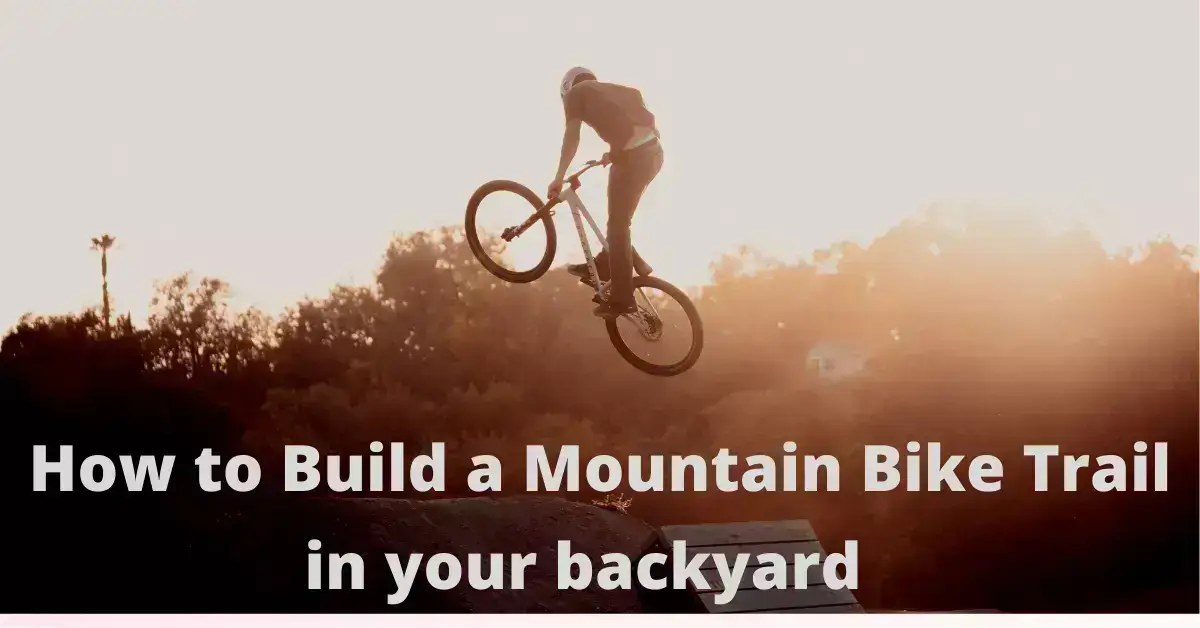The days of sitting on your couch and watching TV are over. The internet has made it possible for anyone to explore the world, and there is no better way than by mountain biking.
If you want an amazing outdoor experience without leaving home, then this article will show you how to make a mountain bike trail in your backyard.
Here is an article on my website that you must read, its about Can You Ride a Mountain Bike With a Broken Spoke? (Interesting Things to Know).
Tools You Will Need:
- Drill
- Shovel
- Wheelbarrow or Bobcat
- Clippers
- Bucket for Moisture
- Wheel Rakes
- Saw
- Pickaxes & Mattocks
- Hoe or Bush Axe (for clearing out brush)
- Half Moon Shovels (my favorite for digging steps and shaping berms)
- lots of patient helpers
- Screws or Nails
- Wood
- Dirt
Step-By-Step Guide On How To Make A Mountain Bike Trail In Your Backyard
Step 1: Find A Location
The first step is to find a location to build your trail. If you live in the mountains or have a huge yard, great! You’re one step closer to building your own trail for mountain biking.
A place where you don’t mind getting dirty and scratching up some grass would be best. I found a forested area and used it for my backyard mountain biking trail.
When finding a good spot for the trail, consider questions like: Is there smooth dirt or technical rocks? Are there steep hills or mellow ones? Finding an appropriate location is key—after that, you want to bring paper and a pen.
Walk around your chosen area taking note of sections with drop-offs, meadows, etc., as well as cliffs/forests/swamps which are not so great. You’ll also need to look out for any obstacles (e.g bushes) that might obstruct your path forward.
Step 2: Outline The Trail
Drawing out the course on paper or with ground markers before actually building is a great way to create more organized and aesthetically pleasing trails.
When scouting trails for a bike, I recommend sketching out the planned routes on paper first. Then go for a walk and mark tape so you’ll find it easier to cultivate your ideas later.
While hiking, ask yourself if you can climb that uphill? or if the turn is too sharp to take; re-route the trail as needed!
Step 3: Set Up The Foundations
Take out all your tools. I used various tools but important tools are handsaw, shovel, weed eater, clippers. The weed-eater was very helpful for clearing out the grass. Then, we started with some of the hard stuff like removing bushes and trees.
I used a shovel, handsaw to clear everything away but it also helped that my friends were willing to help me too. We worked hard enough that they could use it too if they liked it!
I would suggest digging out a road base for your trail to save on time. This is going to be a good base for your trails because it will save you time and effort in the long run, making sure that the dirt doesn’t get too muddy when it rains.
The base size should be 10 by 10 feet, or a foot bigger than the width of your tires. Dig down about 4 inches on the top layer and then add crushed gravel to make it nice and even. You should always have 2 passes with the blade to get rid of any excess rocks.
Remember that you want your tires to be able to fit in those grooves after a run. The road base should be slightly bigger than your tire too, so you don’t lose traction when hitting the grade at full speed.
Step 4: Build The Trail Perfect
Erosion is a big problem in trail building, and it can be hard to stop. The most susceptible sections are berms, jumps, and corners because they erode the fastest. Make sure you assess these areas when looking for erosion so that your trails stay safe!
In order to prevent puddles of water from accumulating on the trail, build canals or small tunnels where rainwater is able to exit. Additionally, make sure that the path has a slight incline so any excess liquid will flow downwards and out.
When creating a dirt jumping course, it’s best to dig at the highest part. Then make your way down by removing dirt from the lower section until you have created an even level surface that can serve as a receiver for jumps if you want to build jumps on it later on.
You don’t want to end up riding on unstable trails that are eroded. So, if you think the rain might erode the trail or it’s beyond your skillset – go ahead and skip building a certain section of it!
Dig small trenches along the curvy portions of each corner so they won’t lose their shape.
To support the corner’s foundation and maintain its curved shape, add logs or small wooden beams to your structure.
Tip: If you want to make a few features for your dirt jumps, then put any excess soil in a wheelbarrow so that when it comes time to create these elements on the bike trail itself, all of this extra soil can be used.
Step 5: Contour Your Trail To Make It More Fun & Interesting
A good way to mix up your trail and make it more interesting is to contour the trail. Contouring the trail will create dips and bumps that give you a fun ride.
I did not have any hoes or bush axes when building my trail so I had to improvise. I would use a pickaxe, shovel, wheel rake, and half-moon shovel to do this.
I dug out the trail halfway, making it dip towards me when riding down it, and then smoothed it all out so that there was a bump at the bottom by where I stood.
Step 6: Add the Trail Features:
Adding features to your trail will be a lot of fun and can add many hours to your trail building. The following are features that I have added:
Stairs, Edges & Walls, Rollable Boulders, Rock drops & Skinnies, Cables, Hubs.
Below Are Some Ideas For Adding More Features To Your Local Trail:
- Add log jumps so riders can cross over obstacles they would otherwise have to go around. Riding up and over logs will be both challenging and fun!
- Installing rock piles so riders can jump off them and try different tricks in the air. This is especially good for those who like speed as well as balance!
- Adding stairs so there is an easier way for riders to climb the trails rather than just walking their bikes.
- Adding steps so there is an easier way to get up slopes on the trail, which will be great for those who are just beginning to mountain bike or aren’t very strong.
- Making bridges across water or other obstacles. This lets riders cross over safely and smoothly.
- Adding berms (curved hills) along the trail so riders can get a little boost when they go down them. This is very helpful for keeping speed and momentum while still having fun!
Step 7: Ride the Trail
Let your friends ride on certain parts of the dirt bike path so they can learn how bumpy different surfaces are and where bumps might appear in future sections of a track.
Don’t give up if occasionally there is a section that isn’t perfect because over time everything smooths out tremendously when riders use their momentum going down hills or after hitting big jumps off high points along the way.
Step 8: Maintenance
The problem is that once a new trail is created it needs to be cared for in order to prevent erosion of the soil or damage by animals.
If there is water flowing across your new trail try to divert its flow using rocks and/or logs. This will help reduce erosion by slowing down the water flow. If you are able to divert the flow of water completely off your trail then so much the better because it will prevent any erosion that might occur. You should also try to reduce or eliminate areas where rainwater collects like drainage ditches and high traffic areas by adding small berms, switchbacks, or rocks.
If you see signs of erosion occurring then fix it quickly because even small amounts can destroy a lot in a short period of time. You should also check these areas regularly during dry periods when they may become susceptible to soil erosion.
Use a leaf rake and/or leaf blower to clean your trail of leaves, sticks, and other debris that might accumulate. This will help prevent the spread of unwanted plants, as well as keep your trail nice and fresh-looking. Freshly groomed trails with plenty of flow are more inviting to bikers than those filled with debris. Try not to waste too much time on this as your main focus should be on preventing erosion.
Keep an eye out for trail blockages by animals such as fallen trees or large rocks that might cause trouble if bikers were to hit them. Pay attention to these areas when you are riding the trail yourself so you can get a feel for where bikers might have trouble.
If you do find blockages then move them to an area that they won’t pose a problem like along the side of the trail or out in the woods.
Here is an article that I have written about Can a Mountain bike be used for touring the city? (Read This First!).
Finishing Your Backyard Mountain Bike Trail
With these steps, you’ll have created the perfect trail! But don’t rush it. You can damage your work if done too quickly or recklessly.
Now you’re ready to take on the trail! Just remember that taking care of these steps will make it safer. Don’t rush through them or else you can cause damage, so be patient and enjoy yourself.
Harden the soil of your trails, you can do this by sprinkling water on it for 2 to 3 days. Once hardened, ride back down the trail without further watering.
Conclusion:
If you’re an avid mountain biker, there’s nothing more frustrating than wanting to ride your bike but not having any trails nearby. But if you have the space and resources for it, building a trail in your backyard is surprisingly straightforward.
There’s no need to go out of your way and spend time going up a mountain when you can make one in the comfort of your backyard.
With this simple guide, anybody will be able to get on their bikes right after they step outside without worrying about whether or not they have reached the trailhead yet.
Another post that will interest you is about What is the Right Age to Start Mountain Biking? (Important Facts!).




